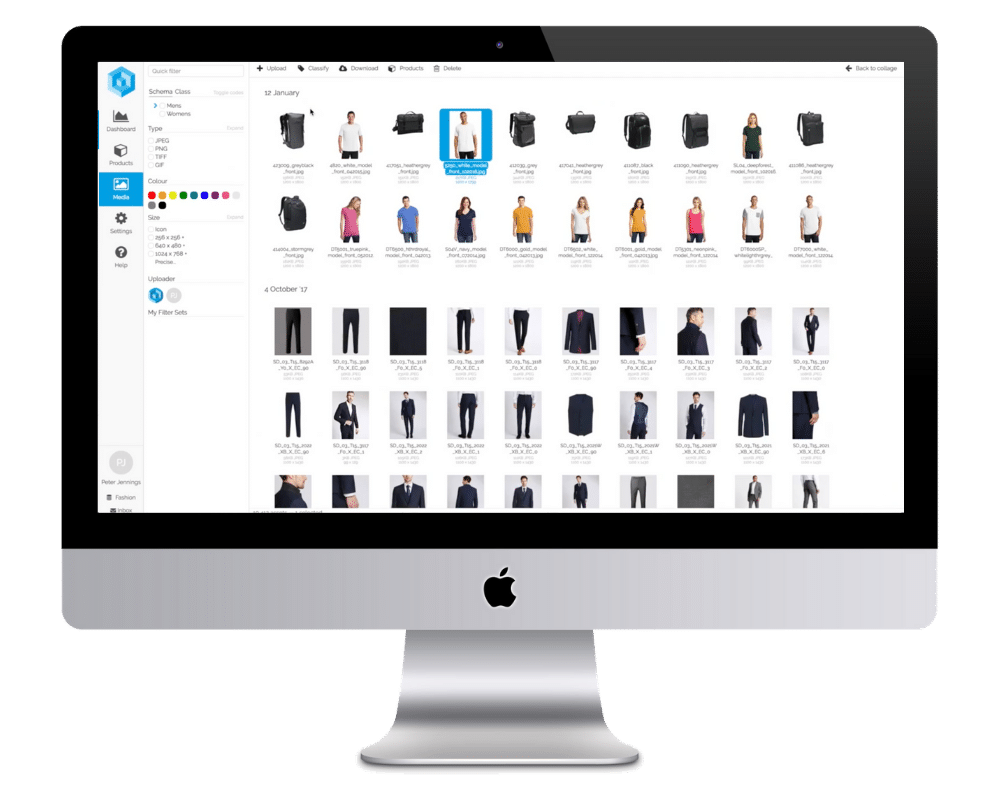Key Takeaways

- AI is the engine behind today’s hybrid shopping patterns, connecting in-store and online shopping into a unified customer experience.
- Leading retailers use AI to personalize recommendations, improve inventory accuracy, and streamline omnichannel fulfillment.
- A Product Information Management (PIM) system is essential because hybrid shopping depends on consistent, enriched, and channel-ready product data.
What Is AI for Hybrid Shopping?
AI for hybrid shopping refers to artificial intelligence tools and workflows that support customer journeys spanning both online and physical environments. This includes everything from AI-powered search and recommendations to in-store clienteling apps, predictive logistics systems, and real-time inventory updates.
According to McKinsey, more than 70% of shoppers use both digital and physical touchpoints before making a purchase—meaning retailers who optimize only one side of the experience lose out on conversions.
AI closes this gap by making sure customers see the right products, at the right time, with accurate information, no matter where they shop.
Use Cases
Common AI hybrid shopping applications include:
-
Smart product recommendations that adjust based on customer behavior in both online and in-store settings.]

-
AI eCommerce search tools powered by natural language processing, enabling shoppers to describe what they want instead of using exact keywords.
-
Real-time inventory prediction that ensures availability for BOPIS (Buy Online, Pick Up In-Store) and same-day delivery.
-
Store associate apps that use AI to provide product suggestions, upsell opportunities, and personalized service.
-
AI-driven product content creation that keeps descriptions, attributes, and images updated across all channels.
Why It Matters for Modern Retailers and eCommerce Teams
Challenge #1: Fragmented Customer Journeys
Shoppers bounce between mobile, desktop, marketplaces, and physical stores. This presents a major challenge: the product they see online must perfectly match the one in-store—same specs, same price, same availability.
Yet many retailers still manage product information manually, leading to inconsistencies that frustrate consumers and increase return rates.
Solution: AI That Connects Online and Offline Experiences
AI helps unify these touchpoints by:
- Standardizing product data across every channel
- Forecasting demand based on customer behavior across all environments
- Automating product content updates to keep information accurate
- Powering AI eCommerce tools that serve relevant results regardless of where shoppers start their search
- Together, these capabilities create a consistent hybrid experience that boosts conversion rates, reduces friction, and strengthens brand trust.
How AI Creates More Personalized Hybrid Shopping Experiences
Key Feature #1: Real-Time Personalization
Leading brands use AI models that analyze browsing behavior, purchase history, and even in-store interactions to deliver personalized product suggestions.

This level of personalization once required enormous labor and manual merchandising. Today, AI automates it with higher accuracy and greater speed.
Use Case Example
Imagine a customer researching running shoes online. They view several neutral-colored options, read reviews, and add one to their wishlist. Later, they walk into the physical store.
An associate equipped with an AI-powered app can instantly see:
- The customer’s wishlist
- Their fit preferences
- Past purchases
- Real-time stock availability
The associate can then recommend a specific shoe and even offer complementary products—socks, insoles, gym bags—based on AI-driven insights.
This combination of human and AI assistance is exactly why hybrid shopping is so effective: consumers get the personalization of eCommerce with the immediacy and confidence of in-store shopping.
AI for Hybrid Shopping and PIM: Why Product Information Matters
Hybrid shopping only works when product information is consistent everywhere. This is where a Product Information Management (PIM) system becomes essential.
AI tools rely on structured, complete, accurate product data—attributes, dimensions, materials, SEO titles, images, marketing descriptions, all of it. If this information changes from one channel to another, customers lose trust and abandon purchases.
A PIM ensures:
- Every channel uses the same enriched product source of truth
- AI search and recommendation models receive consistent data
- In-store systems and ecommerce platforms stay perfectly aligned
- New product launches roll out with complete, channel-ready content
FAQs
Q: How does AI help connect in-store and online shopping?
AI connects these environments by syncing inventory, personalizing recommendations, and ensuring product information stays consistent. When a customer interacts with your brand—whether online or in-store—AI systems update in real time to reflect their preferences and behaviors. This leads to better product discovery, faster fulfillment, and smoother omnichannel transitions.
Q: Does AI require a lot of technical resources to support hybrid shopping?
Not as much as many retailers expect. Most AI eCommerce tools integrate directly with existing platforms like ERP, PIM, and eCommerce systems. Once connected, AI automates product content, updates listings, predicts inventory needs, and improves search—all without requiring heavy engineering work. The biggest prerequisite is having clean, structured, enriched product data.
Conclusion: What This Means for Retailers Looking to Optimize Hybrid Shopping
To summarize: hybrid shopping is no longer an emerging trend—it is the reality of modern commerce. Retailers who want to win in this environment must meet shoppers wherever they are and deliver a consistent experience across every touchpoint.
AI is the most effective way to make that happen. It enables real-time personalization, reduces operational inefficiencies, and ensures customers have accurate product information whether they’re browsing online or talking to an associate in-store.
But the success of AI for hybrid shopping hinges on one thing: high-quality product data. With a PIM system like Pimberly, you can centralize, enrich, and automate your product information, creating a single source of truth that AI systems rely on.
If you’re exploring how to build hybrid shopping experiences that convert, Pimberly can help you streamline product workflows, improve data quality, and support AI-driven customer journeys at scale.














